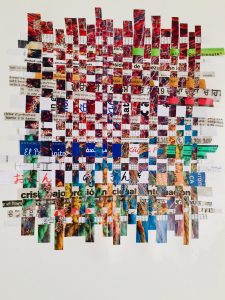BAAL Competition for Visual Representations of Multilingualism 2018-2019
2nd prize
(inter)weaving repertoires

Artist
Gail Prasad
Location
Madison, WI, United States
Artist bio
Gail Prasad is an Assistant Professor in the Faculty of Education at York University in Toronto. Her research investigates linguistic diversity in schools and expansive multilingual pedagogies in school settings. She draws on arts-informed methodologies including drawing, painting, self-portraiture, photography, multiliteracies making and collage to engage children and youth as co-researchers in exploring and representing their experiences with linguistic diversity and as plurilingual social actors. Her work has been published in English and French journals including the International Journal of Bilingualism and Bilingual Education, Language & Intercultural Communication, TESOL Quarterly and glottopol.
Media
mixed media collage
Size
28 x 43 cm
Year
2019
Description
Communication in the 21st century involves not only languages and their varieties but also a range of dynamic multimodal practices. To overcome what Li (2018) describes as ‘lingua bias’ requires a shift from studying (named) languages only as discrete structures to co-investigating with social actors who draw on their expansive communicative repertoires differentially across many contexts. ‘(inter)weaving repertories’ began as a tapestry of burlap and lace woven together with different variegated yarns, threads and twine. Mixed media tapestry as a form reflects how repertoires expand through the addition of new materials. As different fibers are incorporated through various stitching and weaving practices, the tapestry takes on new textures and depth. The resulting tapestry was then scanned to create a digital print. The print in turn was cut into unequal stripes and staggered to reflect differences across individuals’ communicative repertoires. Subsequently, print materials were gathered across a variety of spaces. These found papers were then cut into uneven stripes and woven into printed tapestry strips to reflect how the linguistic landscapes of our lives become interwoven with our communicative repertoires. At first glance ‘(inter)weaving repertoires’ looks like a mosaic made up of contrasting and separate squares that never come together or do more than touch. The weaving process, however, does more than simply bring individuals and their repertoires into contact; interweaving mutually reinforces a stronger, richer and more complex whole. Ultimately, ‘(inter)weaving repertoires” seeks to highlight linguistic diversity as a resource that transforms both individuals and their communities.
